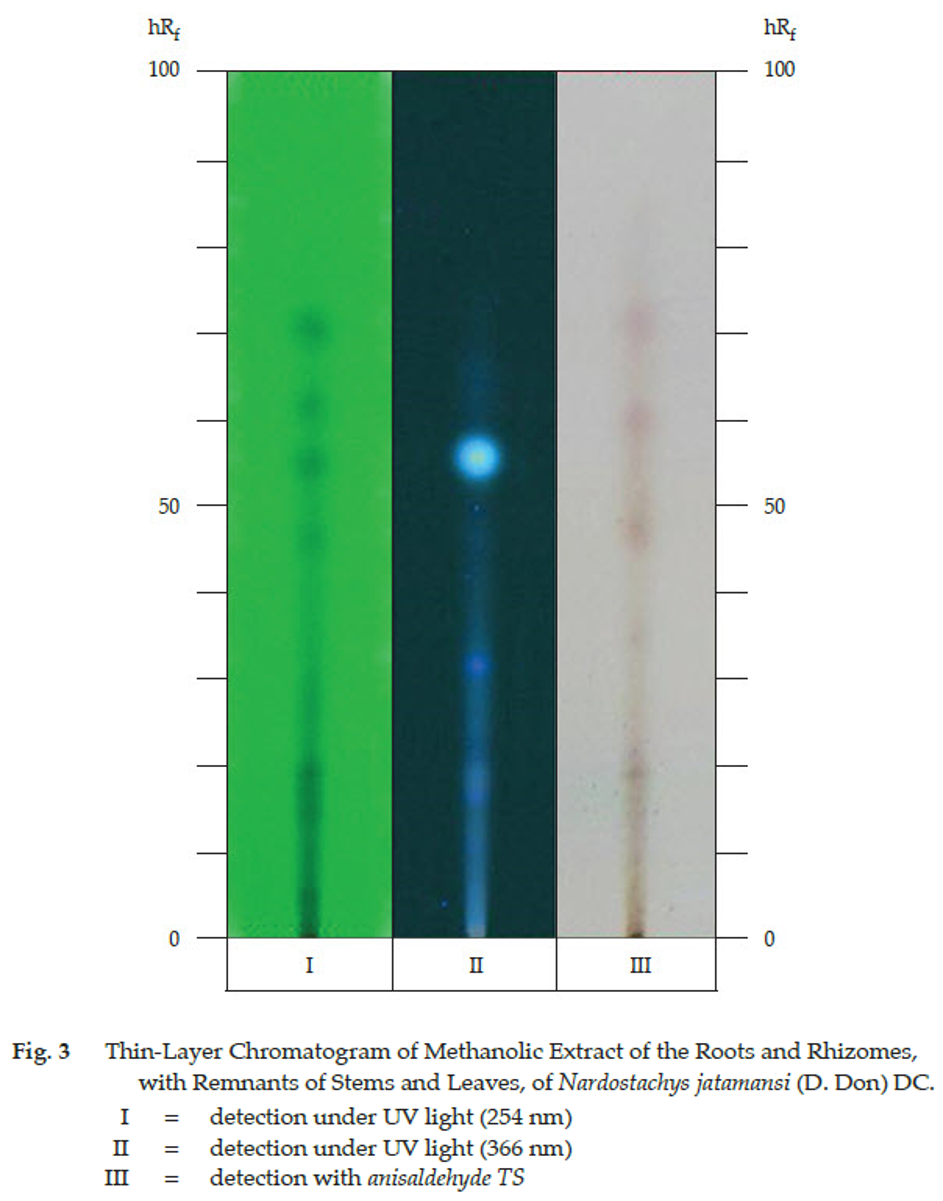ตำรามาตรฐานยาสมุนไพรไทย
Thai Herbal Pharmacopoeia
สำนักยาและวัตถุเสพติด กรมวิทยาศาสตร์การแพทย์ กระทรวงสาธารณสุข
Bureau of Drug and Narcotic, Department of Medical Sciences, Ministry of Public Health(Tinospora crispa (L.) Hook.f. & Thomson)
(Nelumbo nucifera Gaertn.)
(Centella asiatica (L.) Urb.)
(Centella Dry Extract)
(Centella Cream)
(Mesua ferrea L.)
(Piper sarmentosum Roxb.)
(Piper sarmentosum Roxb.)
(Pterocarpus santalinus L. f.)
(Santalum album L.)
(Senna tora (L.) Roxb.)
(Senna alata (L.) Roxb.)
(Senna Alata Tea)
(Piper retrofractum Vahl)
(Myristica fragrans Houtt)
(Andrographis paniculata (Burm. f.) Nees)
(Andrographis Capsules)
(Allium ascalonicum L.)
(Ocimum tenuiflorum L.)
(Curcuma longa L.)
(Turmeric Capsules)
(Turmeric Dry Extract)
(Turmeric Dry Extract Capsules)
(Arcangelisia flava (L.) Merr.)
(Curcuma sp.)
Harrisonia perforata (Blanco) Merr.
(Aristolochia pierrei Lecomte)
(Zingiber officinale Roscoe)
(Ginger Capsules)
(Ginger Tea)
(Cassia fistula L.)
(Nardostachys jatamansi (D. Don) DC.)
(Angelica sinensis (Oliv.) Diels)
Artemisia annua L.
(Ligusticum sinense Oliv. cv. Chuanxiong)
(Neopicrorhiza scrophulariiflora Pennell)
(Atractylodes lancea (Thunb.) DC.)
(Aucklandia lappa Decne)
(Terminalia chebula Retz.)
(Angelica dahurica (Hoffm.) Benth. & Hook. f. ex Franch. & Sav. var. dahurica)
(Kaempferia parviflora Wall. ex Baker)
(Hibiscus sabdariffa L.)
(Roselle Tea)
(Allium sativum L.)
(Zingiber zerumbet (L.) Sm.)
(Wurfbainia testacea (Ridl.) Škorničk.& A. D. Poulsen)
(Cannabis sativa L.)
(Myristica fragrans Houtt)
(Dracaena cochinchinensis (Lour.) S. C. Chen)
(Ficus racemosa L.)
(Hyptis suaveolens (L.) Poit.)
Clerodendrum indicum (L.) Kuntze
(Phyllanthus emblica L.)
(Citrus hystrix DC.)
(Citrus hystrix DC.)
(Areca catechu L.)
(Momordica charantia L.)
Moringa oleifera Lam.
(Aegle marmelos (L.) Corrêa)
(Solanum trilobatum L.)
(Morus alba L.)
Gynostemma pentaphyllum(Thunb.)
Makino
(Clinacanthus nutans (Burm. f.) Lindau)
(Cissus quadrangularis L.)
(Mimusops elengi L.)
(Zingiber montanum (J. König) Link. ex A. Dietr.)
(Piper betle L.)
(Capsicum annuum L.)
(Capsicum Oleoresin)
(Capsicum Gel)
(Piper nigrum L.)
(Piper nigrum L.)
(Eurycoma longifolia Jack)
(Thunbergia laurifolia Lindl.)
(Piper wallichii (Miq.) Hand.-Mazz.)
Senna garrettiana (Craib) H. S. Irwin & Barneby
(Terminalia bellirica (Gaertn.) Roxb.)
(Terminalia chebula Retz.)
(Caesalpinia bonduc (L.) H. Roxb.)
(Tarlmounia elliptica (DC.) H. Rob., S. C. Keeley, Skvaria & R. Chan)
(Hog Creeper Vine Dry Extract Capsiles)
(Hog Creeper Vine Dry Extract)
(Brachypterum scandens (Roxb.) Miq.)
(Lepidium sativum L.)
(Nigella sativa L.)
(Cuminum cyminum L.)
(Foeniculum vulgare Mill.)
(Plantago ovata Forssk.)
(Pimpinella anisum L.)
(Carum carvi L.)
(Anethum graveolens L.)
(Trachyspermum ammi (L.) Sprague)
Albizia procera (Roxb.) Benth.
(Acorus calamus L.)
(Tiliacora triandra (Colebr.) Diels)
Cyanthillium cinereum (L.) H. Rob.
(Orthosiphon aristatus (Blume) Miq.)
Murdannia loriformis (Hassk.) R. S. Rao & Kammathy
(Capparis micracantha DC.)
(Chrysopogon zizanioides (L.) Roberty)
(Cyperus rotundus L.)
(Cannabis sativa L.)
(Syzygium aromaticum (L.) Merr. & L. M. Perry)
(Boesenbergia rotunda (L.) Mansf.)
(Acanthus ebracteatus Vahl)
(Acanthus ilicifolius L.)
(Kaempferia galanga L.)
(Curcuma comosa Roxb.)
Betula alnoides Buch.-Ham. ex D. Don
Cannabis sativa L.
Carthamus tinctorius L
Mitragyna speciosa (Korth.) Havil
Mallotus repandus (Rottler) Müll. Arg
Azadirachta indica A. Juss. var. siamensis Valeton
Azadirachta indica A. Juss. var. siamensis Valeton
Punica granatum L.
Rhinacanthus nasutus (L.) Kurz
Baliospermum solanifolium (Burm.) Suresh
Curcuma aeruginosa Roxb
Boesenbergia kingii Mood & L. M. Prince
Senegalia rugata (Lam.) Britton & Rose
Acacia concinna (Willd.) DC.
Senegalia rugata (Lam.) Britton & Rose
Acacia concinna (Willd.) DC.
Senna alexandriana Mill. var. alexandriana
Cassia acutifolia Delile, Cassia angustifolia Vahl
Butea superba Roxb. ex Willd.
[Plaso superba (Roxb. ex Willd.) Kuntze, Rudolphia superba (Roxb. ex Willd.) Poir.
Pueraria candollei Graham
ex Benth. var. mirifica (Airy Shaw & Suvat.) Niyomdham
Streblus asper Lour.
Suregada multiflora (A. Juss.) Baill. (Gelonium
multiflorum A. Juss.
Spikenard is the dried root and rhizome, with remnants of stem and leaves, of Nardostachys jatamansi (D. Don) DC. (N. grandiflora DC.) (Family Caprifoliaceae), Herbarium Specimen Number: see Additional information 1, Crude Drug Number: DMSc 0939.
Constituents Spikenard contains volatile oil of which sesquiterpenoids (e.g., jatamansone or valeranone, nardosinone) are its major components. It also contains other sesquiterpenoids (e.g., nardin), alkaloids (e.g., actinidine), coumarins, etc.
Description of the plant (Figs. 1a, 1b) Perennial herb; flowering stems 10 to 60 cm tall, puberulous; rhizome woody, foetid, spindle-shaped, elongated, covered with reddish brown fibres. Leaves simple, opposite, basal leaves rosulate, blade elliptic-lanceolate or oblanceolate, 5 to 20 cm long, apex obtuse, base attenuate into petiole, margin entire or sparsely serrate; petiole subequal to leaf blade in length. Inflorescence terminal cymose; capitula 1.5 to 2 cm in diameter; involucral bracts 4 to 6, lanceolate; bract narrowly ovate to ovate, subequal to flower length; peduncles sometime elongated. Flower purple-red, pinkish white, pink, or magenta; calyx 5-lobed, lobe suborbicular to triangular-lanceolate, enlarged in fruit, usually ciliate; corolla tube campanulate, 4.5 to 9 mm long, 5-lobed, lobe broadly ovate to oblong, 2 to 3.8 mm long; stamens 4, subequal to corolla length, filament villous; ovary inferior, style subequal to stamen length. Fruit achene, obovoid, 3 to 4 mm long.
Description Odour, characteristic, pungent and foetid; taste, bitter and pungent.
Macroscopical (Fig. 1a) A bundle of compressed rhizomes, cylindrical, 2.5 to 7.5 cm long, about 1.5 cm in diameter, dark grey or brown, covered by bundles of fine brown fibres forming a network of leaf sheath, easily broken. Root simple- or multiple-joined, branched or juxtaposed, 0.3 to 1 cm in diameter, externally brown, shrunken, with rootlets, texture fragile, easily broken, fracture rough, bark dark brown.
Microscopical (Figs. 2a, 2b, 2c, 2d) Transverse section of the crude drug exhibits remnants of leaves and stem, roots and rhizomes. Remnant leaf composed of cork layers and vascular tissue. Remnant stem comprises cork layers, cortex, vascular tissues, and pith. Root composed of cylindrical epidermal layer, cortex, vascular tissue, and pith. Rhizome comprises cork layers, cortex and vascular tissue.
Transverse section of the remnant leaf shows several layers of thin-walled, cork-like cells with small groups of vascular bundles.
Transverse section of the remnant of stem illustrates several layers of thin-walled cork cells, fibre, numerous round parenchyma in cortex, vascular tissue and numerous thin-walled pith parenchyma in the centre.
Transverse section of the root shows a layer of cylindrical epidermis, round or polygonal, slightly thick-walled parenchyma and endodermis in cortex, polyarch of vascular bundles and numerousthick-walled parenchyma in pith.
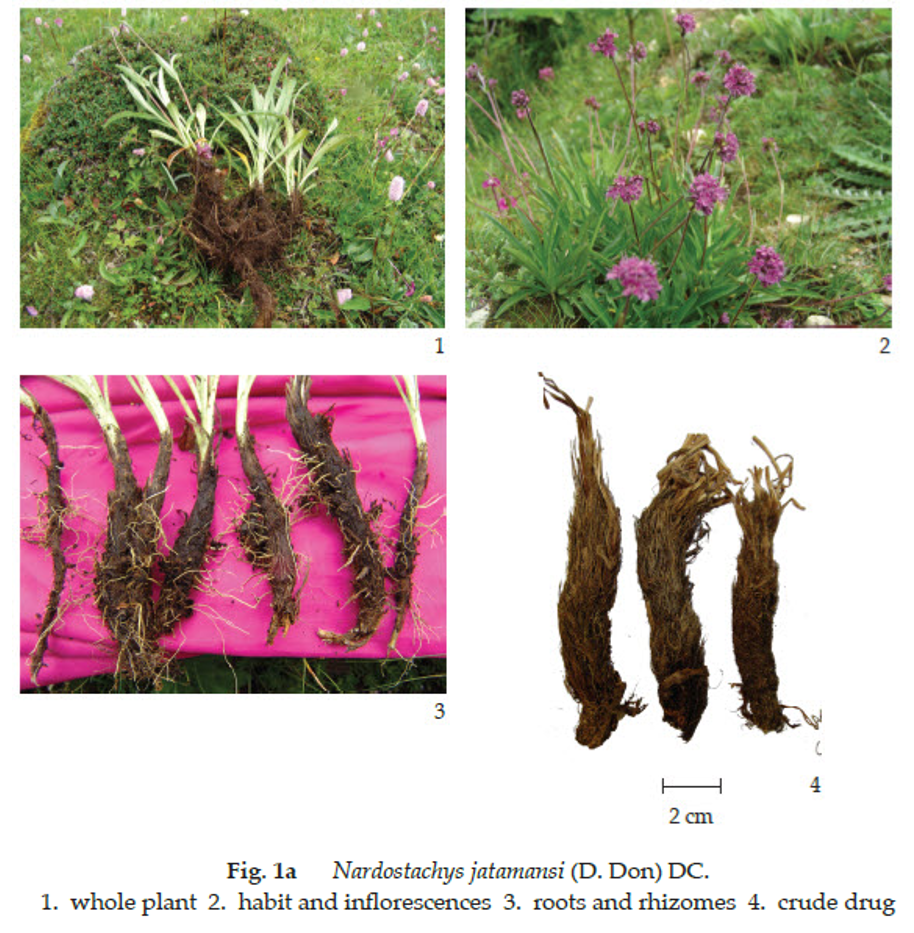
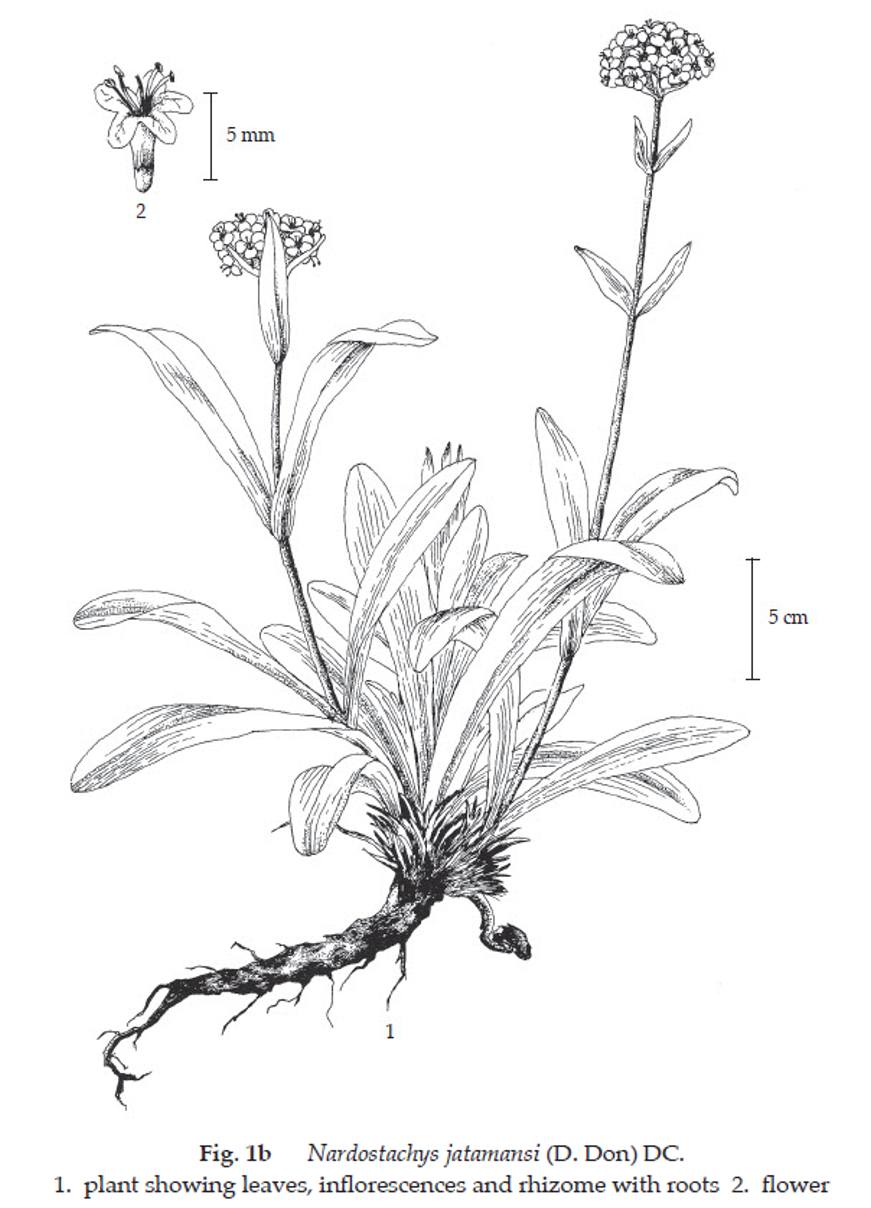

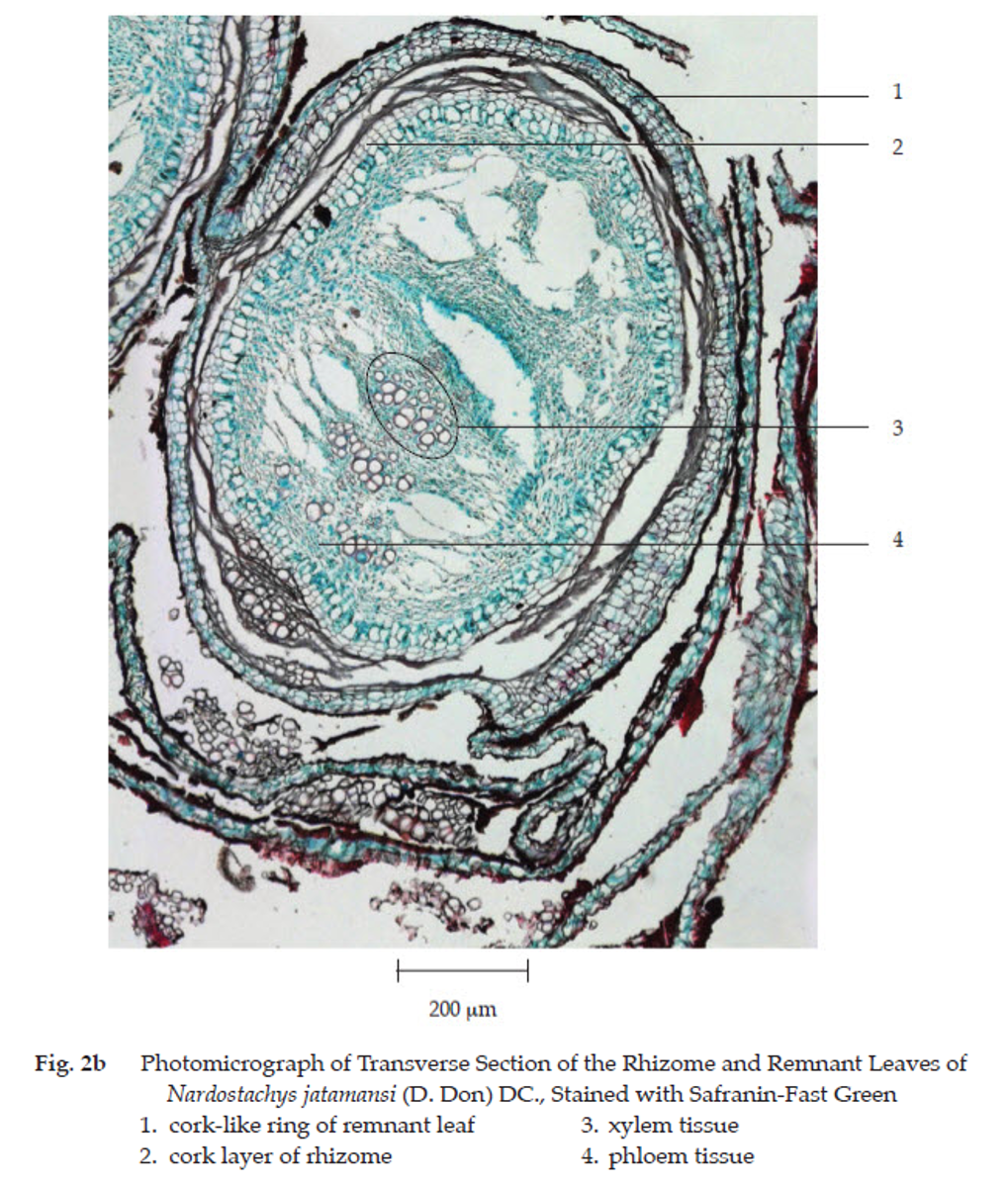
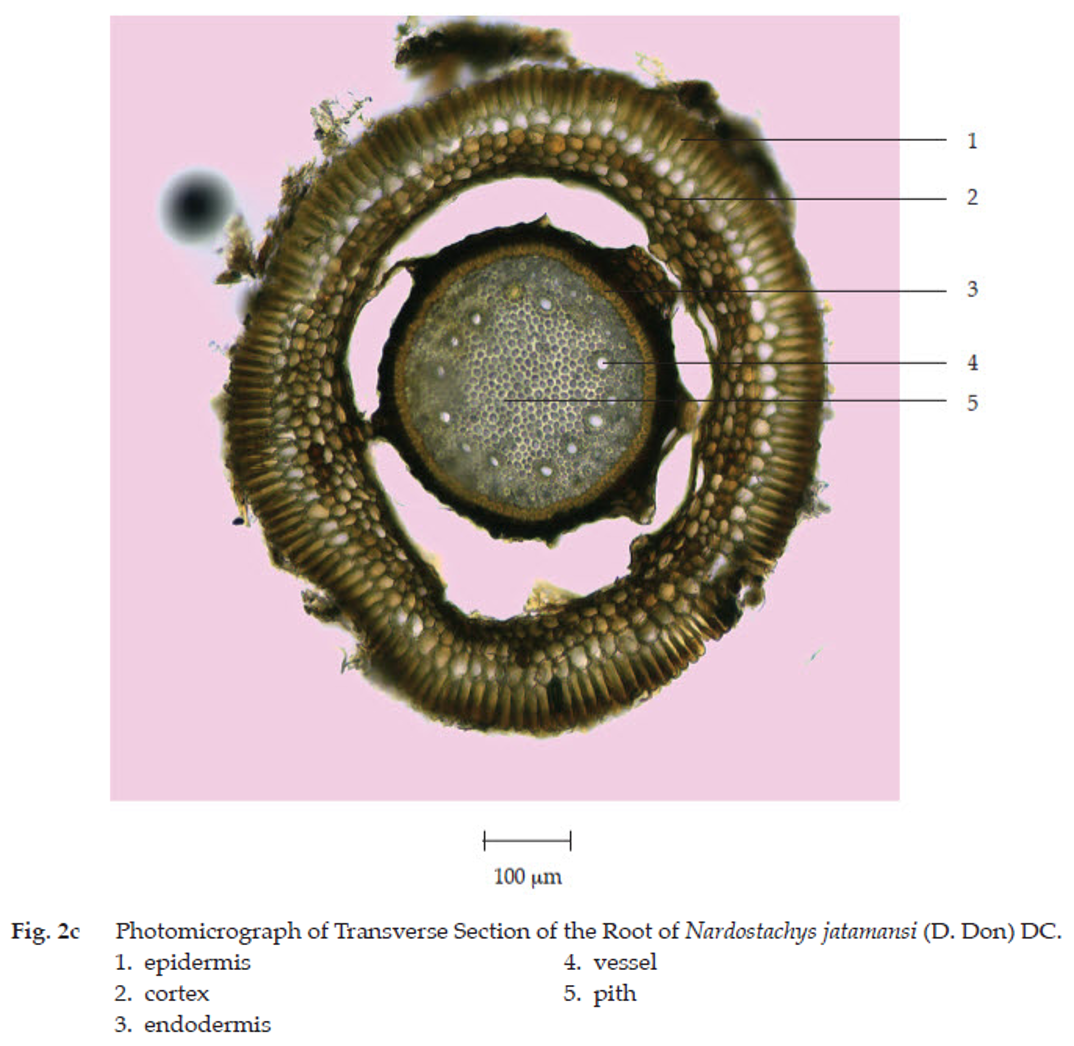
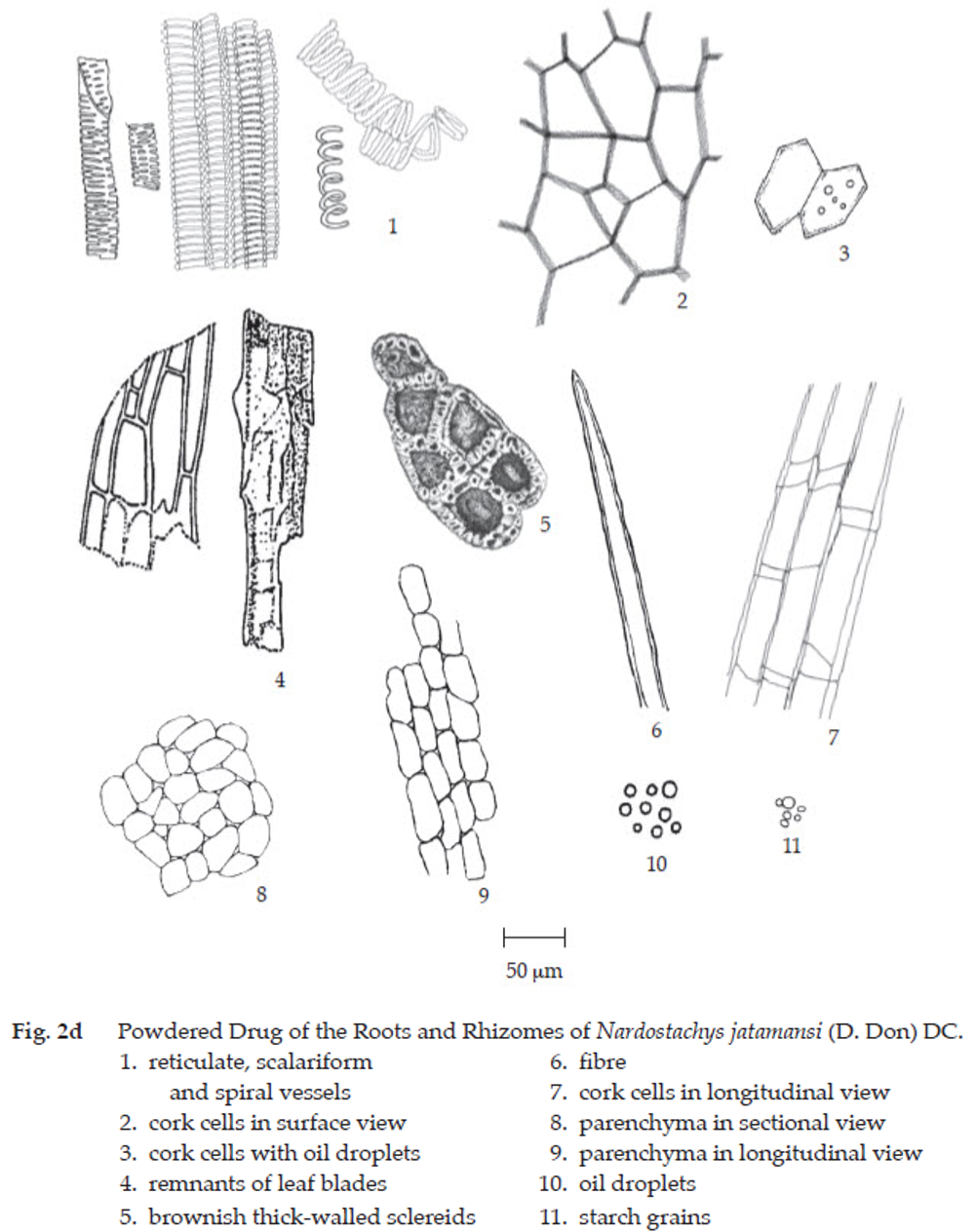
Transverse section of the rhizome shows more than two layers of cork cells, several layers of thin-walled parenchyma in cortex, vascular tissue, parenchyma and large holes in the centre.
Spikenard in powder possesses the diagnostic microscopical characters of the unground drug. Thin-walled, cork-like cells, lignified thick-walled brownish sclereids and oil droplets are abundant.
Contra-indication It is contra-indicated in pregnant women.
Additional information
1. Spikenard plant is not native to nor commercially cultivated in Thailand. The plant yielding spikenard root and rhizome, with remnants of stem and leaves is here referred to the herbarium specimen number K000762790, collector’s number N. Wallich 431, deposited at the Herbarium, Royal Botanic Gardens Kew (K), London, United Kingdom. The photographic illustration of the specimen can be seen at the Department of Medical Sciences Herbarium (DMSC), Nonthaburi, Thailand.
2. It is commonly used with other herbal drugs in Thai traditional herbal preparations.
Packaging and storage Spikenard shall be kept in well-closed containers, preferably of metal or glass, protected from light, and stored in a cool and dry place.
Identification
A. Shake 2 g of the sample, in powder, with 10 mL of chloroform for 15 minutes and filter. To 2 mL of the filtrate, slowly add 1 mL of sulfuric acid to make two layers: a brown ring is produced at the zone of contact.
B. Carry out the test as described in the “Thin-Layer Chromatography” (Appendix 3.1), using silica gel GF254 as the coating substance and a mixture of 70 volumes of n-hexane, 30 volumes of ethyl acetate and 1 volume of acetic acid as the mobile phase and allowing the solvent front to ascend 10 cm above the line of application. Apply to the plate, 5 μL of the test solution prepared by refluxing 1 g of the sample, in powder, with 25 mL of methanol for 30 minutes, filtering and evaporating the filtrate to dryness. Dissolve the residue in 1 mL of methanol. After removal of the plate, allow it to dry in air and examine under ultraviolet light (254 nm), marking the quenching spots. Subsequently examine the plate under ultraviolet light (366 nm) through the cut-off filter; several blue fluorescent spots are observed. Spray the plate with anisaldehyde TS and heat at 110° for 10 minutes; several violet spots appear (Table 1); see also Fig. 3.
Table 1 hRf Values of Components in Methanolic Extract of the Roots and Rhizomes, with Remnants of Stems and Leaves, of Nardostachys jatamansi (D. Don) DC.
| Spot | hRf Value | Detection | ||
| UV 254 | UV 366 | Anisaldehyde TS | ||
| 1 2 3 4 5 6 7 8 |
2-6 16-20 30-32 32-36 43-48 52-58 58-63 66-72 |
quenching quenching - - quenching quenching quenching quenching |
- light blue light blue - - blue - - |
- violet - violet violet - violet violet |
Water Not more than 12.0 per cent v/w (Azeotropic Distillation Method, Appendix 4.12).
Foreign matter Not more than 2.0 per cent w/w (Appendix 7.2).
Acid-insoluble ash Not more than 6.0 per cent w/w (Appendix 7.6).
Total ash Not more than 11.0 per cent w/w (Appendix 7.7).
Ethanol-soluble extractive Not less than 2.0 per cent w/w (Appendix 7.12).
Water-soluble extractive Not less than 5.0 per cent w/w (Appendix 7.12).
Volatile oil Not less than 1.0 per cent v/w (Appendix 7.3H). Use 20 g, in coarse powder, freshly prepared and accurately weighed. Use 200 mL of water as the distillation liquid and a 500-mL round-bottomed flask. Distil at a rate of 2 to 3 ml per minute for 5 hours. Use 2.0 mL of xylene in the graduated tube.
Dose 2 to 3 g of the powdered drug a day.
